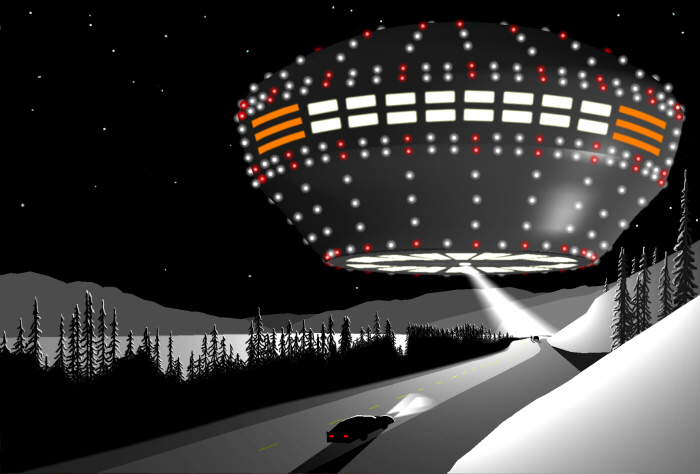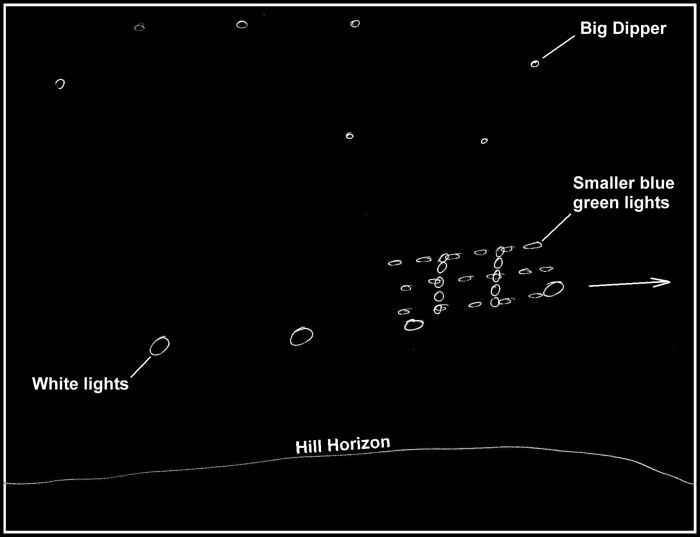The documentary film Best Evidence: Top 10 UFO Sightings lists this "multiple witness sighting in the Yukon" as number eight of the top ten UFO cases of all time. In that film the celebrated "Flying Saucer Physicist" Stanton Friedman says of this case:
"The Yukon case IS emblematic of what a good case should be. I mean, sure, we'd like to have a piece of the craft, we'd like to have the crewmember introduced for dinner. BUT multiple independent witnesses lasting a long time, describing something that's WAY outside the norm, -- there's no way you can make it into a 747, for example [chuckle]. And big, but this was much much bigger than a 747. "
 | |
| UFO "Mothership" sighted from the Klondike Highway, Yukon Territory, Dec. 11, 1996. |
Longtime UFOlogist Michael Swords of CUFOS says:
Not knowing [investigator] Martin Jasek I can't "stand up in court" on this one, but everything that I've heard says that this is not only a "good" but possibly one of the best cases ever… I look forward to any of the gang clearing my misconceptions up on this case, because right now it might be one I'd "take into war" with me.
On April 4, the British skeptic Ian Ridpath sent around email to a number of active UFO skeptics, asking if anyone had information on this case. James Oberg replied that he was unable to help because he was in Beijing, China, headed for North Korea! James traveled with the NBC news team to witness North Korea's new missile, before its (unsuccessful) launch. His reporting on this unprecedented trip is on his website, http://www.jamesoberg.com/ .
 |
| Witness PEL2 drew the UFO passing below the Big Dipper |
When he returned, Oberg contacted the Canadian satellite expert Ted Molczan with the details of this case. Molczan is probably the world's top civilian expert on observing earth satellites and calculating satellite orbits. Molczan looked into the matter carefully, and came up with an exact match: "the observed phenomena were due to the re-entry of the 2nd stage of the rocket that placed Cosmos 2335 into orbit earlier the same day." Should anyone doubt this, Molczan provides details of the mathematical calculations that support this conclusion.
James Oberg placed a comment on the "Above Top Secret" forum discussing this case.
 |
| Molczan's software-generated plot of the decay of the rocket booster for Cosmos 2335 |
Stimulus / Response
A case of this type affords us an excellent opportunity to judge the credibility of eyewitness testimony. Given a known stimulus "in," what is the observer's response "out"? In other words, how accurately did the observers' descriptions match the known stimulus? Not well at all!
Report: "many rows of lights"
Reality: The booster disintegrated into an irregular train of debris, that was perceived as an orderly pattern of "lights" on a huge solid object.
Report: "As he was walking his flashlight happened to point in the direction of the UFO. As if reacting to his flashlight, the UFO started speeding rapidly toward him."
Reality: the "UFO reacting" to him was entirely in his imagination. The rocket booster did not react to his flashlight.
Report: the UFO was hovering approximately 300 yards in front of the observer. "Hynek Classification: CE1" (Close Encounter of the First Kind).
Reality: the distance to the re-entering booster was approximately 233 km (145 miles), so this was not a "close encounter." At no time did it stop, or hover.
Report: The UFO was approximately 500-750 meters (up to 1/2 mile) in length.
Reality: It is impossible to estimate the size of an unknown object unless its distance is known. Since the disintegrating booster was about 145 miles distant, its debris train must have been spread over many miles.
Report: "The interior lights in her car started to go dim and the music from her tape deck slowed down."
Reality: This effect was entirely in the observer's imagination. The rocket booster did not affect her car's electronics.
Report: "stars blocked out" by huge UFO.
Reality: the observers were viewing a long train of debris from the disintegrating rocket booster. It was not a solid object, and thus could not have "blocked out" stars. However, the light from the reentry may have made nearby stars difficult to see.
 |
| ESA illustration of a satellite disintegrating and burning up upon re-entry to earth's atmosphere |
Molczan closed his analysis by saying,
Experienced sky watchers on SeeSat-L may find it difficult to believe that anyone could misidentify a re-entry as a spaceship, but human perception is notoriously fallible, and no one is immune. Much depends on the circumstances and personal experience. Driving through the wilderness under a pitch black sky, and suddenly faced with a slowly moving formation of brilliant lights can be awe-inspiring and even terrifying. The human mind races to make sense of the unfamiliar, drawing on experience that may be inadequate. Depth perception can play tricks, such that something 200 km away, 100 km long, and moving at 7 km/s, seems to be just 200 m away, 100 m long, and moving 7 km/h - the angular velocity is roughly the same. Taking these considerations into account, the eyewitnesses did a pretty good job, and need not be embarrassed for having perceived more than was there.He left out the part about reports of the object hovering, the electrical interference, etc. Not "a pretty good job" in my book.
Here we have yet another clear-cut example of extraordinary reports ("giant UFO Mothership!") arising from a perfectly ordinary (if rare) phenomenon. Therefore, the existence of extraordinary reports does not suggest the existence of extraordinary objects. It is perfectly possible to get extraordinary reports from ordinary objects.
Which gives us more evidence of the wisdom of the Royal Society of London, the world's first scientific body founded in 1660, taking as its motto "nullius in verba' : take nobody's word for it!


0 comments:
Post a Comment